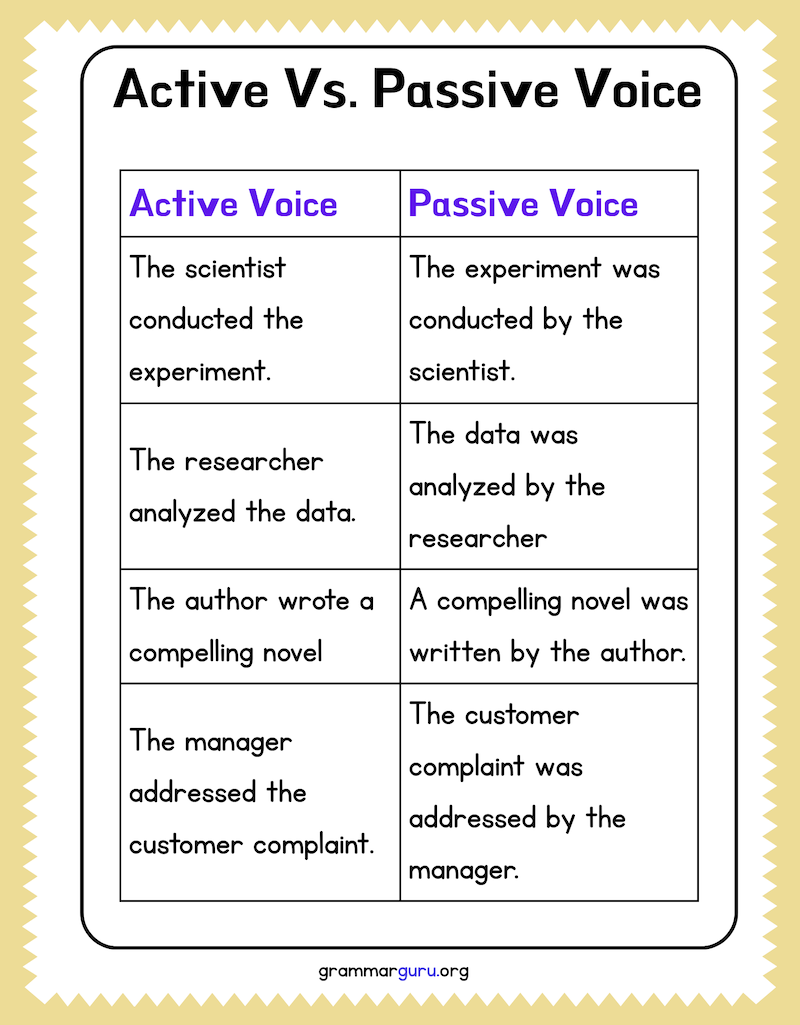Understanding the difference between active vs passive voice can make your writing clearer and more engaging. Many students struggle with when to use each, but with simple explanations and examples, you can master both.
What is Active Voice?
In active voice, the subject of the sentence performs the action. It follows this structure:
Subject → Verb → Object
Examples of active voice:
- The dog chased the ball.
- Students completed their assignments.
- Our team won the championship.
- The chef prepared a delicious meal.
- The professor explained the concept.
In each example, the subject (dog, students, team, chef, professor) performs the action. This creates dynamic, clear sentences that show who does what.
What is Passive Voice?
In passive voice, the subject receives the action. The structure is:
Object → Verb (with helping verb) → Subject (optional)
Examples of passive voice:
- The ball was chased by the dog.
- The assignments were completed by the students.
- The championship was won by our team.
- A delicious meal was prepared by the chef.
- The concept was explained by the professor.
Notice how each sentence focuses first on what receives the action, not who performs it. Sometimes, the subject might be omitted entirely: “The ball was chased” or “The assignments were completed.”
Active vs Passive Voice : Examples
| Active Voice (Subject does the action) | Passive Voice (Subject receives the action) |
| Focuses on who does the action (subject → verb → object). | Focuses on what receives the action (object → verb → subject) often with “by”. |
| The teacher graded the exams. | The exams were graded by the teacher. |
| The dog chased the cat. | The cat was chased by the dog. |
| Maria baked a cake. | A cake was baked by Maria. |
| The storm damaged the house. | The house was damaged by the storm. |
When to use Active Voice
Use active voice when:
- You want clear, concise sentences.
- The subject is important.
- Writing essays, stories, or emails.
Example:
- The team won the game. (Stronger than The game was won by the team.)
When to use Passive Voice
Use passive voice when:
- The doer is unknown or unimportant.
- Emphasizing the action over the subject.
- Writing scientific or formal reports
Example:
- The experiment was conducted in a lab. (Focus is on the experiment, not who did it.)
How to Identify and Change Passive to Active
- Find the subject, verb, and object.
- Ask: Who is doing the action?
- Rewrite so the subject acts.
Passive: The letter was sent by Sarah.
Active: Sarah sent the letter.
Practice Exercises for Active vs Passive Voice
- Identify whether these sentences use active or passive voice:
- The tornado destroyed several homes in the neighborhood.
- The annual report was submitted by the finance department.
- Scientists discovered a new species in the rainforest.
- The ceremony was attended by hundreds of people.
- Convert these active sentences to passive voice:
- The chef created an award-winning recipe.
- Students organize the annual fundraiser.
- The committee rejected our proposal.
- My brother wrote this song.
- Convert these passive sentences to active voice:
- The castle was built by medieval craftsmen.
- The error was noticed by the proofreader.
- The policy was implemented by the administration.
- The painting was admired by art critics worldwide.

See more:
